一、前言
前面我们知道了 Mybatis 是如何进行代理的, 但是最终 PlainMethodInvoker 中是如何将参数转组装成 sql ,并执行处理 Sql 返回值的地方还都没看到。本篇我们就带着如下三个问题开始我们的探索吧。

本篇内容因为涉及跟 jdbc 的知识,如果对这部分内容有点遗忘,请先JDBC知识复习,另本篇内容知识点较多,目录较复杂,建议根据文字结合 代码在实践的过程中一起学习。最好也可以自己debug一下。会收获更大。做好准备现在发车。
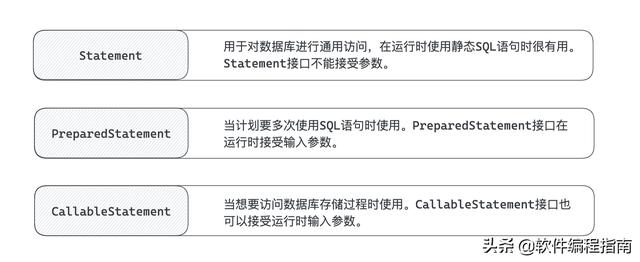
二、流程分析 2.1 Sql是如何组装参数的?
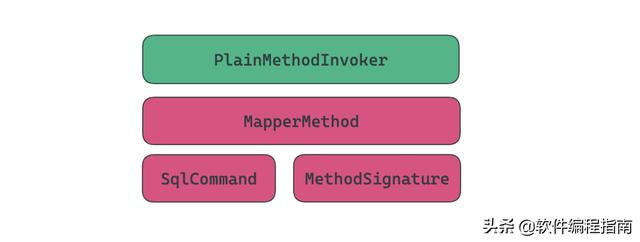
在组装参数之前我们先来提一个小问题,sql的类型是如何判断的。sql类型有增删该查。 除了查询会有结果集外,其他三种都是返回更新行数。他们对应的处理逻辑也是不一样的。 我们要先弄清这个问题。
2.1.1 sql类型如何判断?
我们知道sql的类型是可以通过关键字来判断的,如select/update/delete/insert。那么在Mybatis中哪里能输入sql呢? 一种有2种方式。
- 在Mapper.xml中直接编写sql,如下示例。
<?xml version="1.0" encoding="UTF-8"?>
<!DOCTYPE mapper PUBLIC "-//mybatis.org//DTD Mapper 3.0//EN" "http:// mybatis .org/dtd/mybatis-3-mapper.dtd">
<mapper namespace="orm.example.dal.mapper.TUserMapper">
<delete id="deleteByPrimaryKey" parameterType="java.lang.String">
delete from T_USER
where token_id = #{tokenId,jdbcType=CHAR}
</delete>
<insert id="insert" parameterType="orm.example.dal.model.TUser">
insert into T_USER (token_id, uid, name)
values (#{tokenId,jdbcType=CHAR}, #{uid,jdbcType=INTEGER}, #{name,jdbcType=CHAR})
</insert>
<update id="updateByPrimaryKey" parameterType="orm.example.dal.model.TUser">
update T_USER
set uid = #{uid,jdbcType=INTEGER},
name = #{name,jdbcType=CHAR}
where token_id = #{tokenId,jdbcType=CHAR}
</update>
<select id="selectAll" resultMap="BaseResultMap">
select token_id, uid, name
from T_USER
</select>
</mapper>
- 在Mapper类中使用注解编写sql
public interface TUserMapper {
@Select("select * from t_user where id = #{id}")
TUser selectById(Long id);
}
这些sql信息都保存在 Mapped statement 。在PlainMethodInvoker通过SqlCommand进行调用。
- line(9) 最终通过type = ms.getSqlCommandType() 获取sql的类型
SqlCommand sqlCommand = new SqlCommand(config, mapperInterface, method);
// 构造参数中找MappedStatement
public SqlCommand( Configuration configuration, Class<?> mapperInterface, Method method) {
final String methodName = method.getName();
final Class<?> declaringClass = method.getDeclaringClass();
MappedStatement ms = resolveMappedStatement(mapperInterface, methodName, declaringClass,
configuration);
type = ms.getSqlCommandType();
}
// 寻找方法是接口全路径名.方法名
private MappedStatement resolveMappedStatement(){
String statementId = mapperInterface.getName() + "." + methodName;
configuration.hasStatement(statementId)
}
那么MappedStatement中的SqlCommandType是如何获取的呢?
2.1.1.1 xml文件方式
解析xml标签来实现
XMLMapperBuilder#parseStatementNode
- line(11) 通过标签来映射成指定的类型SqlCommandType
public class XMLStatementBuilder extends BaseBuilder {
public void parseStatementNode() {
String id = context.getStringAttribute("id");
String databaseId = context.getStringAttribute("databaseId");
if (!databaseIdMatchesCurrent(id, databaseId, this.requiredDatabaseId)) {
return;
}
String nodeName = context.getNode().getNodeName();
SqlCommandType sqlCommandType = SqlCommandType.valueOf(nodeName.toUpperCase(Locale.ENGLISH));
}
}
public enum SqlCommandType {
UNKNOWN, INSERT, UPDATE, DELETE, SELECT, FLUSH
}
2.1.1.2 注解方式
一定是解析注解方法 annotation Wrapper。将不同的注解解析成SqlCommandType。如下伪代码。通过解析方法上的注解,判断 注解 类型,来确定sql的类型。 MapperAnnotationBuilder#getAnnotationWrapper(method, true, statementAnnotationTypes)
private class AnnotationWrapper {
private final Annotation annotation;
private final String databaseId;
private final SqlCommandType sqlCommandType;
AnnotationWrapper(Annotation annotation) {
super();
this.annotation = annotation;
if (annotation instanceof Select) {
databaseId = ((Select) annotation).databaseId();
sqlCommandType = SqlCommandType.SELECT;
} else if (annotation instanceof Update) {
databaseId = ((Update) annotation).databaseId();
sqlCommandType = SqlCommandType.UPDATE;
} else if (annotation instanceof Insert) {
databaseId = ((Insert) annotation).databaseId();
sqlCommandType = SqlCommandType.INSERT;
} else if (annotation instanceof Delete) {
databaseId = ((Delete) annotation).databaseId();
sqlCommandType = SqlCommandType.DELETE;
} else if (annotation instanceof SelectProvider) {
databaseId = ((SelectProvider) annotation).databaseId();
sqlCommandType = SqlCommandType.SELECT;
} else if (annotation instanceof UpdateProvider) {
databaseId = ((UpdateProvider) annotation).databaseId();
sqlCommandType = SqlCommandType.UPDATE;
} else if (annotation instanceof InsertProvider) {
databaseId = ((InsertProvider) annotation).databaseId();
sqlCommandType = SqlCommandType.INSERT;
} else if (annotation instanceof DeleteProvider) {
databaseId = ((DeleteProvider) annotation).databaseId();
sqlCommandType = SqlCommandType.DELETE;
} else {
sqlCommandType = SqlCommandType.UNKNOWN;
if (annotation instanceof Options) {
databaseId = ((Options) annotation).databaseId();
} else if (annotation instanceof SelectKey) {
databaseId = ((SelectKey) annotation).databaseId();
} else {
databaseId = "";
}
}
}
Annotation getAnnotation() {
return annotation;
}
SqlCommandType getSqlCommandType() {
return sqlCommandType;
}
}
到这里我们知道了sql类型是如何区分出来的,既然能区分出来,就知道如何去执行sql了。 是不是很简单? 当然看的话很简单,但是如何让你自己来找,你能找到吗? 所以建议在阅读的时候 要自己去源码中找找。
2.1.2 sql参数如何组装?
在mybatis中有两种处理sql参数的地方,第一种是 #{} 占位符,第二种是 ${} 变量符。这两种都是处理参数的方式。那说到这里,不得不提的就是 sql注入 的黑客技术。 sql注入就是就是利用了变量符。将我们原来的sql进行恶意的修改。举一个例子。下面根据用户id和用户密码查询用户信息。
select * from t_user as u where u.pass = ${user_pass} and u.id = ${user_id}
那么如何在不知道密码只有用户id的情况下查询到用户信息呢? 我们只需要将sql转换成下面这样即可。
select * from t_user as u where u.pass = ” or 1 = 1 and u.id = ${user_id}
那mybatis允许我们这样做吗? 允许,如果我们使用的是 ${} 变量符,那么mybatis只是将参数和变量符进行替换。你输入的参数可能也会被当成sql去执行了。如下代码示例。
public interface T4UserMapper {
/**
* 获取用户信息
*
* @param uid 用户id
* @param tokenId token
* @return TUser
*/ @Select("select * from t_user where token_id = ${token_id} and uid = ${uid}")
TUser queryUserById(@Param("uid") Long uid, @Param("token_id") String tokenId);
}
public class Test{
@Test
public void sql(){
// 读取配置信息
InputStream mapperInputStream = Thread.currentThread().getContextClassLoader().getResourceAsStream("example05/mybatisConfig.xml");
// 生成SqlSession工厂,SqlSession从名字上看就是,跟数据库交互的会话信息,负责将sql提交到数据库进行执行
SqlSessionFactory sqlSessionFactory = new SqlSessionFactoryBuilder().build(mapperInputStream, "development");
// 获取Mybatis配置信息
Configuration configuration = sqlSessionFactory.getConfiguration();
SqlSession sqlSession = sqlSessionFactory.openSession(false);
// debug
T4UserMapper mapper = configuration.getMapper(T4UserMapper.class, sqlSession);
// 模拟sql注入
System.out.println(mapper.queryUserById(37L,"0 or 1 = 1"));
}
}
Setting autocommit to false on JDBC Connection [com.mysql.cj.jdbc.ConnectionImpl@62ddbd7e]
==> Preparing: select * from t_user where token_id = 0 or 1 = 1 and uid = 37
==> Parameters:
<== Columns: uid, name, token_id
<== Row: 37, 无天, 60
<== Total: 1
TUser(tokenId=null, uid=37, name=无天)
要想避免这样的问题,我们只需要将 ${} 变量符,都替换成 #{} 占位符就好了。那么Mybatis只会将你的参数当做是参数处理,不会当做是sql执行。如下代码示例。
public interface T4UserMapper {
/**
* 获取用户信息
*
* @param uid 用户id
* @param tokenId token
* @return TUser
*/ @Select("select * from t_user where token_id = #{token_id} and uid = #{uid}")
TUser queryUserById(@Param("uid") Long uid, @Param("token_id") String tokenId);
}
public class Test{
@Test
public void sql(){
// 读取配置信息
InputStream mapperInputStream = Thread.currentThread().getContextClassLoader().getResourceAsStream("example05/mybatisConfig.xml");
// 生成SqlSession工厂,SqlSession从名字上看就是,跟数据库交互的会话信息,负责将sql提交到数据库进行执行
SqlSessionFactory sqlSessionFactory = new SqlSessionFactoryBuilder().build(mapperInputStream, "development");
// 获取Mybatis配置信息
Configuration configuration = sqlSessionFactory.getConfiguration();
SqlSession sqlSession = sqlSessionFactory.openSession(false);
// debug
T4UserMapper mapper = configuration.getMapper(T4UserMapper.class, sqlSession);
// 模拟sql注入 => null
System.out.println(mapper.queryUserById(37L,"0 or 1 = 1"));
}
}
Created connection 798981583.
Setting autocommit to false on JDBC Connection [com.mysql.cj.jdbc.ConnectionImpl@2f9f7dcf]
==> Preparing: select * from t_user where token_id = ? and uid = ?
==> Parameters: 0 or 1 = 1(String), 37(Long)
<== Total: 0
null
以上演示代码可以在 com.test.example05.SqlParseTest 中找到。那么无论是变量符还是占位符,其实都是sql组装,下面我们正式开始学习。
==同样我们先提两个问题==

2.1.2.1 方法参数如何来解析

关键代码就在MapperMethod的execute的入参 Object [] args; 关于参数的处理都在这里处理了。MethodSignature# convert ArgsToSqlCommandParam。
public class MapperMethod {
public Object execute(SqlSession sqlSession, Object[] args) {
Object result;
switch (command.getType()) {
case INSERT: {
Object param = method.convertArgsToSqlCommandParam(args);
result = rowCountResult(sqlSession.insert(command.getName(), param));
break;
}
case UPDATE: {
Object param = method.convertArgsToSqlCommandParam(args);
result = rowCountResult(sqlSession.update(command.getName(), param));
break;
}
case DELETE: {
Object param = method.convertArgsToSqlCommandParam(args);
result = rowCountResult(sqlSession.delete(command.getName(), param));
break;
}
....
return result;
}
}
public Object convertArgsToSqlCommandParam(Object[] args) {
return paramNameResolver.getNamedParams(args);
}
参数会被解析成什么样呢? 关键代码就在这里。
public Object getNamedParams(Object[] args) {
final int paramCount = names.size();
// 没有参数直接返回
if (args == null || paramCount == 0) {
return null;
} else if (!hasParamAnnotation && paramCount == 1) {
// 没有注解只有一个参数
Object value = args[names.firstKey()];
return wrapToMapIfCollection(value, useActualParamName ? names.get(0) : null);
} else {
final Map<String, Object> param = new ParamMap<>();
int i = 0;
// names key = 参数下标 value = @Param里面的值
for (Map.Entry<Integer, String> entry : names.entrySet()) {
// key = @Param里面的值,value = args[index] 真实数据
param.put(entry.getValue(), args[entry.getKey()]);
// 生成param1,参数
final String genericParamName = GENERIC_NAME_PREFIX + (i + 1);
// ensure not to overwrite parameter named with @Param
if (!names.containsValue(genericParamName)) {
param.put(genericParamName, args[entry.getKey()]);
}
i++;
}
return param;
}
}
我们直接说结论,如果方法签名中使用了@Param注解结论,则占位符中的参数名就是注解的值。如果没有注解在就是arg+参数的位置.
com.test.example04.MethodSignatureTest
参数类型 方法签名 参数值 结果 解析单参数不带@Param TUser queryUserByName(String name) methodSignature.convertArgsToSqlCommandParam(new Object[]{“孙悟空”}) 孙悟空 解析单参数带@Param TUser queryUserById(@Param(“userId”) Long id) methodSignature.convertArgsToSqlCommandParam(new Object[]{1L}) {userId=1, param1=1} 解析多参数不带@Param TUser queryUserByTokenId(Long tokenId,String name) methodSignature.convertArgsToSqlCommandParam(new Object[]{1L, “孙悟空”}) {arg0=1, arg1=孙悟空, param1=1, param2=孙悟空} 解析多参数带@Param TUser queryUserByTokenId(@Param(“tokenId”) Long tokenId, @Param(“name”) String name) methodSignature.convertArgsToSqlCommandParam(new Object[]{1L, “孙悟空”}) {tokenId=1, name=孙悟空, param1=1, param2=孙悟空}
如果项目编译中设置了编译后保存参数名,那么可以获取代码中编写的参数名。
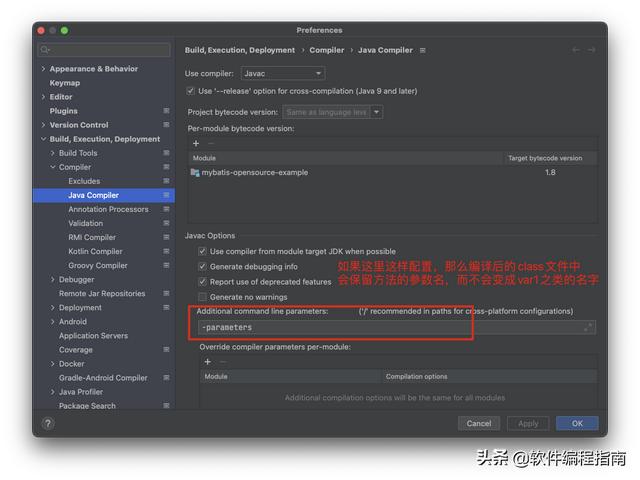
好了到这里我们知道方法的参数最终都会被Mybatis重新解析,解析后的结果可以看以上的表格。主要就是为拼装参数提前准备数据。下面我们看sql信息最终是如何最终组装的吧。
2.1.2.2 方法参数组装
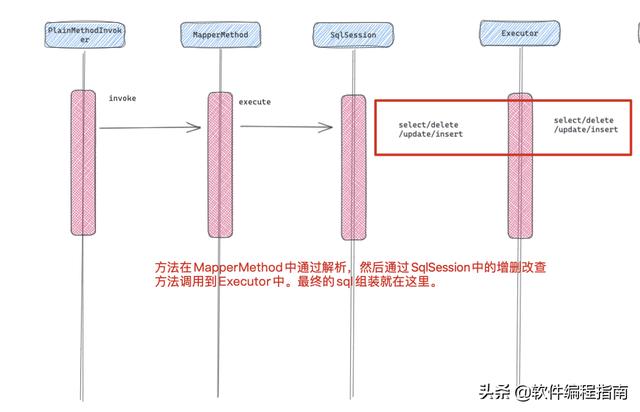
这里我们思考一下,变量符应该是动态sql,在调用jdbc时候应该是下面的例子。
PreparedStatement preparedStatement = connection.prepareStatement("select * from t_user where token_id = 0 or 1 = 1 and uid = 37");
那么我们就寻找哪里有这样的代码。
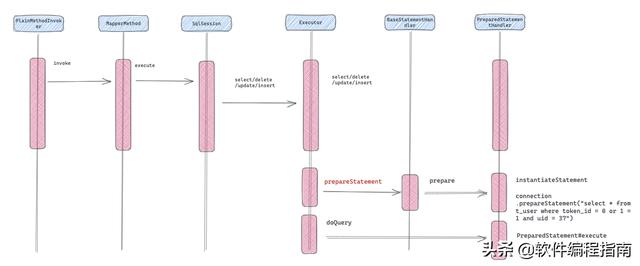
PreparedStatementHandler#instantiateStatement.
@Override
protected Statement instantiateStatement(Connection connection) throws SQLException {
String sql = boundSql.getSql();
if (mappedStatement.getKeyGenerator() instanceof Jdbc3KeyGenerator) {
String[] keyColumnNames = mappedStatement.getKeyColumns();
if (keyColumnNames == null) {
return connection.prepareStatement(sql, PreparedStatement.RETURN_GENERATED_KEYS);
} else {
return connection.prepareStatement(sql, keyColumnNames);
}
} else if (mappedStatement.getResultSetType() == ResultSetType.DEFAULT) {
return connection.prepareStatement(sql);
} else {
return connection.prepareStatement(sql, mappedStatement.getResultSetType().getValue(), ResultSet.CONCUR_READ_ONLY);
}
}
关键的代码就在这里静态sql,直接从MappedStatement#getBoundSql(Object parameterObject)#getSql()获取组装后的代码。
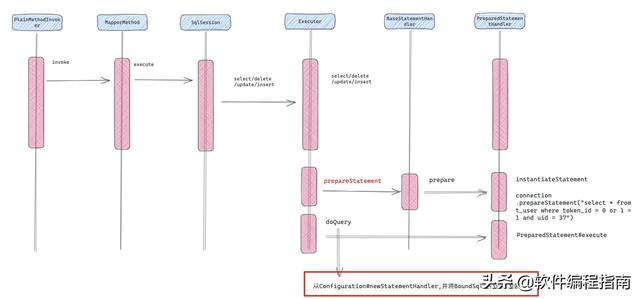
@Override
public <E> List<E> doQuery(MappedStatement ms, Object parameter, RowBounds rowBounds, ResultHandler resultHandler, BoundSql boundSql) throws SQLException {
Statement stmt = null;
try {
Configuration configuration = ms.getConfiguration();
StatementHandler handler = configuration.newStatementHandler(wrapper, ms, parameter, rowBounds, resultHandler, boundSql);
stmt = prepareStatement(handler, ms.getStatementLog());
return handler.query(stmt, resultHandler);
} finally {
closeStatement(stmt);
}
}
// 这里parameterObject就是前面对方法参数的解析返回值。通过mappedStatement.getBoundSql(parameterObject)组装静态sql
protected PreparedStatementHandler(Executor executor, MappedStatement mappedStatement, Object parameterObject, RowBounds rowBounds, ResultHandler resultHandler, BoundSql boundSql) {
this.configuration = mappedStatement.getConfiguration();
this.executor = executor;
this.mappedStatement = mappedStatement;
this.rowBounds = rowBounds;
this.typeHandlerRegistry = configuration.getTypeHandlerRegistry();
this.objectFactory = configuration.getObjectFactory();
if (boundSql == null) { // issue #435, get the key before calculating the statement
generateKeys(parameterObject);
boundSql = mappedStatement.getBoundSql(parameterObject);
}
this.boundSql = boundSql;
this.parameterHandler = configuration.newParameterHandler(mappedStatement, parameterObject, boundSql);
this.resultSetHandler = configuration.newResultSetHandler(executor, mappedStatement, rowBounds, parameterHandler, resultHandler, boundSql);
}
好了,到这里我们就知道静态sql是哪里组装的了。关键点就在BoundSql这个类是如何构建的。我们以注解方式举例。
在构建MappedStatement的时候,MapperBuilderAssistant#parse会解析Mapper类所有的方法,获取方法上的注解,生成Sql的信息。 判断sql类型,如果是${}变量符,Sql资源就是DynamicSqlSource动态Sql。如果是#{}占位符就是RawSqlSource会将占位符替换成 ? ,同时生成ParameterMapping信息 用于方法执行时候使用PreparedStatement去set参数信息。
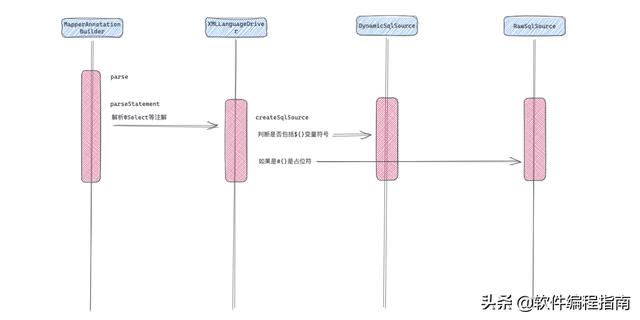
下面我们以示例中的代码来看下BoundSql中究竟有什么信息。

那么对于第一种DynamicSqlSource动态sql,参数信息是如何组装的呢?
public class DynamicSqlSource implements SqlSource {
private final Configuration configuration;
private final SqlNode rootSqlNode;
public DynamicSqlSource(Configuration configuration, SqlNode rootSqlNode) {
this.configuration = configuration;
this.rootSqlNode = rootSqlNode;
}
@Override
public BoundSql getBoundSql(Object parameterObject) {
DynamicContext context = new DynamicContext(configuration, parameterObject);
// 处理sql中如果有<if><where><Trim>等自带标签的情况,同时处理将变量符提供换成真正的参数。
rootSqlNode.apply(context);
// 当执行完上面的流程变量符就被替换成真正的参数了。下面在看是否同时也包含了#{}占位符,如果包含就替换成?
// 在调换成?的同时新增一个ParameterMapping对象
SqlSourceBuilder sqlSourceParser = new SqlSourceBuilder(configuration);
Class<?> parameterType = parameterObject == null ? Object.class : parameterObject.getClass();
SqlSource sqlSource = sqlSourceParser.parse(context.getSql(), parameterType, context.getBindings());
BoundSql boundSql = sqlSource.getBoundSql(parameterObject);
context.getBindings().forEach(boundSql::setAdditionalParameter);
return boundSql;
}
}
核心的方法就是变量符替换,下面直接将核心的代码展示出来。
@Test
public void dynamicSql() throws Exception {
// 读取配置信息(为什么路径前不用加/,因为是相对路径。maven编译后的资源文件和class文件都是在一个包下,所以不用加/就是当前包目录)
InputStream mapperInputStream = Thread.currentThread().getContextClassLoader().getResourceAsStream("example05/mybatisConfig.xml");
// 生成SqlSession工厂,SqlSession从名字上看就是,跟数据库交互的会话信息,负责将sql提交到数据库进行执行
SqlSessionFactory sqlSessionFactory = new SqlSessionFactoryBuilder().build(mapperInputStream, "development");
// 获取Mybatis配置信息
Configuration configuration = sqlSessionFactory.getConfiguration();
// 生成动态Sql
TextSqlNode textSqlNode = new TextSqlNode("select * from t_user where token_id = ${token_id} and uid = ${uid}");
DynamicSqlSource dynamicSqlSource = new DynamicSqlSource(configuration, textSqlNode);
// 装参数
MapperMethod.ParamMap<Object> paramMap = new MapperMethod.ParamMap<Object>();
paramMap.put("uid",37L);
paramMap.put("token_id","0 or 1 = 1");
BoundSql boundSql = dynamicSqlSource.getBoundSql(paramMap);
System.out.println(boundSql.getSql());
}
@Test
public void dynamicSql2(){
// 读取配置信息(为什么路径前不用加/,因为是相对路径。maven编译后的资源文件和class文件都是在一个包下,所以不用加/就是当前包目录)
InputStream mapperInputStream = Thread.currentThread().getContextClassLoader().getResourceAsStream("example05/mybatisConfig.xml");
// 生成SqlSession工厂,SqlSession从名字上看就是,跟数据库交互的会话信息,负责将sql提交到数据库进行执行
SqlSessionFactory sqlSessionFactory = new SqlSessionFactoryBuilder().build(mapperInputStream, "development");
// 获取Mybatis配置信息
Configuration configuration = sqlSessionFactory.getConfiguration();
// 装参数
MapperMethod.ParamMap<Object> paramMap = new MapperMethod.ParamMap<Object>();
paramMap.put("uid",37L);
paramMap.put("token_id","0 or 1 = 1");
DynamicContext context = new DynamicContext(configuration, paramMap);
// 生成动态Sql
TextSqlNode textSqlNode = new TextSqlNode("select * from t_user where token_id = ${token_id} and uid = ${uid}");
textSqlNode.apply(context);
System.out.println(context.getSql());
}
好了,我们知道动态sql其实就是${},变量符号替换。 下面我们看静态sql是如何处理占位符的吧。
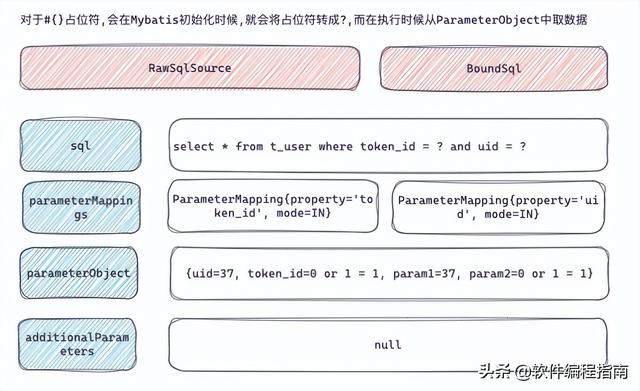
前面我们说了静态sql,在初始化时候就会将占位符替换成? 同时生成一个ParameterMapping对象,然后在执行sql时候通过PreparedStatement进行set参数信息。 那么我们先看占位符如何替换成?的吧。实现逻辑其实就在RawSqlSource的构造方法中。
- line(1-5) 在Mybatis初始化时候,会生成RawSqlSource。在构造中去调换占位符
- line(8-19) 占位符替换的实现方式,最终生成StaticSqlSource
- line(22-28) 占位符返回?的同时,生成一个ParameterMapping对象
public RawSqlSource(Configuration configuration, String sql, Class<?> parameterType) {
SqlSourceBuilder sqlSourceParser = new SqlSourceBuilder(configuration);
Class<?> clazz = parameterType == null ? Object.class : parameterType;
sqlSource = sqlSourceParser.parse(sql, clazz, new HashMap<>());
}
// sql = select * from t_user where token_id = #{token_id} and uid = #{uid}
public SqlSource parse(String originalSql, Class<?> parameterType, Map<String, Object> additionalParameters) {
ParameterMappingTokenHandler handler = new ParameterMappingTokenHandler(configuration, parameterType, additionalParameters);
// 对
GenericTokenParser parser = new GenericTokenParser("#{", "}", handler);
String sql;
if (configuration.isShrinkWhitespacesInSql()) {
sql = parser.parse(removeExtraWhitespaces(originalSql));
} else {
sql = parser.parse(originalSql);
}
return new StaticSqlSource(configuration, sql, handler.getParameterMappings());
}
// 会将占位符号#{token_id}替换成 ?同时生成一个ParameterMapping对象。
private static class ParameterMappingTokenHandler extends BaseBuilder implements TokenHandler {
// content = token_id
@Override
public String handleToken(String content) {
parameterMappings.add(buildParameterMapping(content));
return "?";
}
}
到这里占位符的解析已经很清楚了。BoundSql中的数据我们也知道了,我们直接看参数组装的逻辑吧。

- 从boundSql中获取占位符信息。
- 根据占位符获取参数信息
- 根据参数类型确定使用那个TypeHandler,如果都没有指定就用UnknownTypeHandler
- UnknownTypeHandler会根据参数的类型,从默认配置中找到要用的类型,如果是Long类型就是PreparedStatement#setLong,如果是String类型就是PreparedStatement#setString
public class DefaultParameterHandler implements ParameterHandler {
@Override
public void setParameters(PreparedStatement ps) {
ErrorContext.instance().activity("setting parameters").object(mappedStatement.getParameterMap().getId());
List<ParameterMapping> parameterMappings = boundSql.getParameterMappings();
if (parameterMappings != null) {
for (int i = 0; i < parameterMappings.size(); i++) {
ParameterMapping parameterMapping = parameterMappings.get(i);
if (parameterMapping.getMode() != ParameterMode.OUT) {
Object value;
String propertyName = parameterMapping.getProperty();
if (boundSql.hasAdditionalParameter(propertyName)) { // issue #448 ask first for additional params
value = boundSql.getAdditionalParameter(propertyName);
} else if (parameterObject == null) {
value = null;
} else if (typeHandlerRegistry.hasTypeHandler(parameterObject.getClass())) {
value = parameterObject;
} else {
MetaObject metaObject = configuration.newMetaObject(parameterObject);
value = metaObject.getValue(propertyName);
}
TypeHandler typeHandler = parameterMapping.getTypeHandler();
JdbcType jdbcType = parameterMapping.getJdbcType();
if (value == null && jdbcType == null) {
jdbcType = configuration.getJdbcTypeForNull();
}
try {
typeHandler.setParameter(ps, i + 1, value, jdbcType);
} catch (TypeException | SQLException e) {
throw new TypeException("Could not set parameters for mapping: " + parameterMapping + ". Cause: " + e, e);
}
}
}
}
}
}
好了到这里我们就搞清楚Mybatis中的参数是如何组装的了。 以及Jdbc是如何执行sql的了。 这部分内容比较复杂,仅仅通过看是看不明白的,建议根据文中的代码自己走一边。加深理解。
下面我们看Mybatis是如何处理返回值的吧。
2.2 Sql结果集是如何转换方法返回值的?
我们重新回到PreparedStatementHandler中跟数据库打交道的地方,当PreparedStatement#execute发送sql给数据库后,最终处理结果集的类是 ResultHandler,下面我们就围绕这个类做分析。
@Override
public <E> List<E> query(Statement statement, ResultHandler resultHandler) throws SQLException {
PreparedStatement ps = (PreparedStatement) statement;
ps.execute();
return resultSetHandler.handleResultSets(ps);
}
ResultSetHandler,我们看接口定义,处理结果集就在这里了。我们再来看实现。
public interface ResultSetHandler {
<E> List<E> handleResultSets(Statement stmt) throws SQLException;
<E> Cursor<E> handleCursorResultSets(Statement stmt) throws SQLException;
void handleOutputParameters(CallableStatement cs) throws SQLException;
}
默认的实现DefaultResultSetHandler。Mybatis实现较为复杂,我们一开始可能看不懂。我们先用原生的jdbc来自己实现一边。 然后脑子里有一个思路,然后在根据思路来看DefaultResultSetHandler的实现吧。
2.2.1 JDBC提供的结果处理API
思路是statement执行完后会返回结果集ResultSet。 结果集包含了返回的数据及这些数据对应的字段信息。 然后拿到这些字段信息分别从结果集中获取数据。下面的代码如果明白了,我们就去看Mybatis中的源码
@Test
public void resultMetaData() throws Exception {
String dbUrl = "jdbc:mysql://127.0.0.1:3306/test";
String user = "root";
String pass = "123456";
// 1. 获取数据库连接
Connection connection = DriverManager.getConnection(dbUrl, user, pass);
Statement statement = connection.createStatement();
// 2. 执行sql语句获取结果集
ResultSet resultSet = statement.executeQuery("select uid,name,token_id as tokenId from T_User");
// 3. 从结果集中,获取数据库返回的数据列名
ResultSetMetaData metaData = resultSet.getMetaData();
int columnCount = metaData.getColumnCount();
// 所有的列名
List<String> columnNames = new ArrayList<>();
// 列名对应的java类型
Map<String, Class<?>> column2JavaTypeAsMap = new HashMap<>();
for (int i = 1; i <= columnCount; i++) {
System.out.println("字段:" + metaData.getColumnName(i) + "是否自增:" + metaData.isAutoIncrement(i));
System.out.println("字段名:" + metaData.getColumnName(i));
System.out.println("字段别名:" + metaData.getColumnLabel(i));
System.out.println("MySql字段类型:" + metaData.getColumnTypeName(i));
// Java 类的完全限定名称
System.out.println("Java字段类型:" + metaData.getColumnClassName(i));
// 获取指定列的指定列大小。
System.out.println("字段长度:" + metaData.getPrecision(i));
System.out.println("字段保留小数位:" + metaData.getScale(i));
System.out.println("字段属于的表名:" + metaData.getTableName(i));
System.out.println("是否可为空:" + metaData.isNullable(i));
// 这里使用别名,如果没有别名的情况,别名跟字段名是一样的。
columnNames.add(metaData.getColumnLabel(i));
column2JavaTypeAsMap.put(metaData.getColumnLabel(i), Class.forName(metaData.getColumnClassName(i)));
}
int row = 1;
while (resultSet.next()) {
System.out.println("----------第" + row + "行数据开始----------");
for (String columnName : columnNames) {
Object columnValue = getValue(columnName, resultSet, column2JavaTypeAsMap);
System.out.println("列:" + columnName + ":value:" + columnValue);
}
System.out.println("----------第" + row + "行数据结束----------");
row++;
}
resultSet.close();
statement.close();
connection.close();
}
/**
* 根据不同的字段类型,调用不同的方法获取数据
*
* @param columnName 列名
* @param resultSet 集合集
* @param column2JavaTypeAsMap 字段对应的Java类型
* @return 结果值
* @throws Exception 未知异常
*/ public Object getValue(String columnName, ResultSet resultSet, Map<String, Class<?>> column2JavaTypeAsMap) throws Exception {
Class<?> column2JavaType = column2JavaTypeAsMap.get(columnName);
Object value = null;
if (column2JavaType.equals(Integer.class)) {
value = resultSet.getInt(columnName);
} else if (column2JavaType.equals(String.class)) {
value = resultSet.getString(columnName);
}
return value;
}
字段:uid是否自增:true
字段名:uid
字段别名:uid
MySql字段类型:INT
Java字段类型:java.lang.Integer
字段长度:11
字段保留小数位:0
字段属于的表名:t_user
是否可为空:0
字段:name是否自增:false
字段名:name
字段别名:name
MySql字段类型:CHAR
Java字段类型:java.lang.String
字段长度:32
字段保留小数位:0
字段属于的表名:t_user
是否可为空:1
字段:token_id是否自增:false
字段名:token_id
字段别名:tokenId
MySql字段类型:CHAR
Java字段类型:java.lang.String
字段长度:64
字段保留小数位:0
字段属于的表名:t_user
是否可为空:0
----------第1行数据开始----------
列:uid:value:37
列:name:value:无天
列:tokenId:value:60
----------第1行数据结束----------
----------第2行数据开始----------
列:uid:value:9846
列:name:value:斗战胜佛
列:tokenId:value:80
----------第2行数据结束----------
----------第3行数据开始----------
列:uid:value:9847
列:name:value:净坛使者
列:tokenId:value:90
----------第3行数据结束----------
----------第4行数据开始----------
列:uid:value:9848
列:name:value:无量功德佛祖
列:tokenId:value:100
----------第4行数据结束----------
ResultSetMetaData 方法是比较重要的,这里把他常用的api方法及解释以表格形式列举一下。 当我们拿到返回的列名,就可以直接根据列名来返回数据了。
方法 含义 示例 ResultSetMetaData#getColumnName 获取数据库字段名 name ResultSetMetaData#getColumnLabel 查询语句中字段别名,如果没有保持跟字段名一致 user_id as userId,这里就是userId ResultSetMetaData#getColumnTypeName 返回Sql字段类型 INT、CHAR ResultSetMetaData#getColumnClassName 返回Java字段类型的完整限定名 java.lang.String、java.lang.Integer ResultSetMetaData#getPrecision 获取定义的字段长度 int(11),返回11 ResultSetMetaData#getScale 获取字段定义的保留小数位 – ResultSetMetaData#getTableName 字段对应的表 – ResultSetMetaData#isNullable 字段是否可以为空 – ResultSetMetaData#isAutoIncrement 是否数据库自增字段 – ResultSetMetaData#isAutoIncrement 是否数据库自增字段 –
2.2.2 Mybatis获取结果集
思考下结果集可能是什么?
- 场景一: 可能返回的是List
@Select("select * from t_user")
List<TUser> queryAllUsers();
- 场景二: 可能返回的是单个对象
@Select("select * from t_user where uid = #{uid}")
TUser queryUserByPlaceholderId(@Param("uid") Long uid);
- 场景三: 更新语句返回结果集是条数。
@Update("update t_user set name = #{name}")
int updateName(@Param("uid") Long uid, @Param("name") String name);
- 场景四: 更新语句返回boolean
@Update("update t_user set name = #{name} where uid = #{uid}")
boolean updateNameById(@Param("uid") Long uid, @Param("name") String name);
分别来分析。
场景一:
public class MapperMethod {
private final MethodSignature method;
public Object execute(SqlSession sqlSession, Object[] args) {
Object result;
switch (command.getType()) {
case SELECT:
if (method.returnsVoid() && method.hasResultHandler()) {
executeWithResultHandler(sqlSession, args);
result = null;
} else if (method.returnsMany()) {
result = executeForMany(sqlSession, args);
} else if (method.returnsMap()) {
result = executeForMap(sqlSession, args);
} else if (method.returnsCursor()) {
result = executeForCursor(sqlSession, args);
} else {
Object param = method.convertArgsToSqlCommandParam(args);
result = sqlSession.selectOne(command.getName(), param);
if (method.returnsOptional()
&& (result == null || !method.getReturnType().equals(result.getClass()))) {
result = Optional.ofNullable(result);
}
}
break;
case FLUSH:
result = sqlSession.flushStatements();
break;
default:
throw new BindingException("Unknown execution method for: " + command.getName());
}
if (result == null && method.getReturnType().isPrimitive() && !method.returnsVoid()) {
throw new BindingException("Mapper method '" + command.getName()
+ " attempted to return null from a method with a primitive return type (" + method.getReturnType() + ").");
}
return result;
}
}
可以看到这里对于方法的返回值判断是根据MethodSignature,MethodSignature不仅提供了对参数的解析,同时也是对方法的分析。 包括判断方法的返回值,我们看它的内部属性。
public static class MethodSignature {
// 是否返回集合
private final boolean returnsMany;
// 是否返回是map结构
private final boolean returnsMap;
// 是否没有返回值
private final boolean returnsVoid;
// 是否返回的是游标
private final boolean returnsCursor;
// 是否返回的是Optional对象
private final boolean returnsOptional;
// 返回值类型
private final Class<?> returnType;
// 返回map结构使用的key字段
private final String mapKey;
// 如果入参是ResultHandler 记录器下标
private final Integer resultHandlerIndex;
// 如果参数是RowBounds,记录其下标
private final Integer rowBoundsIndex;
// 参数处理
private final ParamNameResolver paramNameResolver;
}
如果发现是返回List。则MethodSignature#returnsMany=true。直接调用SqlSession#selectList
private <E> Object executeForMany(SqlSession sqlSession, Object[] args) {
List<E> result;
Object param = method.convertArgsToSqlCommandParam(args);
// 方法中是否包含逻辑分页参数RowBounds
if (method.hasRowBounds()) {
// 如果有就获取逻辑分页参数
RowBounds rowBounds = method.extractRowBounds(args);
// 执行sql
result = sqlSession.selectList(command.getName(), param, rowBounds);
} else {
result = sqlSession.selectList(command.getName(), param);
}
// issue #510 Collections & arrays support
if (!method.getReturnType().isAssignableFrom(result.getClass())) {
if (method.getReturnType().isArray()) {
return convertToArray(result);
} else {
return convertToDeclaredCollection(sqlSession.getConfiguration(), result);
}
}
return result;
}
最终在DefaultResultSetHandler#handleResultSets处理返回值。下面的代码看了先不要害怕,其实 思路跟我们用jdbc来处理是一样的。第一要拿到返回的数据信息。第二要将返回的数据信息包装成方法的返回值。 只不过Mybatis将上面的两个能力,都提供成了对应的接口。其中数据的返回集就是ResultSetWrapper,从返回集中获取数据是TypeHandler。 而将数据库返回的行数据,转换成方法的返回值就要用到ResultMap。
@Override
public List<Object> handleResultSets(Statement stmt) throws SQLException {
ErrorContext.instance().activity("handling results").object(mappedStatement.getId());
final List<Object> multipleResults = new ArrayList<>();
int resultSetCount = 0;
// 读取返回的数据信息(jdbcType,javaType,列名和别名)
ResultSetWrapper rsw = getFirstResultSet(stmt);
// Mapper签名中找到返回集应该信息
List<ResultMap> resultMaps = mappedStatement.getResultMaps();
int resultMapCount = resultMaps.size();
// 做个校验,如果sql执行后没有任何返回信息,但是Mapper签名中却指定了返回映射信息。则会报错告警 A query was run and no Result Maps were found for the Mapped Statement
validateResultMapsCount(rsw, resultMapCount);
while (rsw != null && resultMapCount > resultSetCount) {
ResultMap resultMap = resultMaps.get(resultSetCount);
// 处理返回集
handleResultSet(rsw, resultMap, multipleResults, null);
rsw = getNextResultSet(stmt);
cleanUpAfterHandlingResultSet();
resultSetCount++;
}
String[] resultSets = mappedStatement.getResultSets();
if (resultSets != null) {
while (rsw != null && resultSetCount < resultSets.length) {
ResultMapping parentMapping = nextResultMaps.get(resultSets[resultSetCount]);
if (parentMapping != null) {
String nestedResultMapId = parentMapping.getNestedResultMapId();
ResultMap resultMap = configuration.getResultMap(nestedResultMapId);
handleResultSet(rsw, resultMap, null, parentMapping);
}
rsw = getNextResultSet(stmt);
cleanUpAfterHandlingResultSet();
resultSetCount++;
}
}
return collapseSingleResultList(multipleResults);
}
下面我们看这几个关键类。ResultSetWrapper。这个的源码是不是有点想我们前面自己写的原生jdbc的方法了? 拿到返回的列名和对应的java类型。
public ResultSetWrapper(ResultSet rs, Configuration configuration) throws SQLException {
super();
this.typeHandlerRegistry = configuration.getTypeHandlerRegistry();
this.resultSet = rs;
final ResultSetMetaData metaData = rs.getMetaData();
final int columnCount = metaData.getColumnCount();
for (int i = 1; i <= columnCount; i++) {
columnNames.add(configuration.isUseColumnLabel() ? metaData.getColumnLabel(i) : metaData.getColumnName(i));
jdbcTypes.add(JdbcType.forCode(metaData.getColumnType(i)));
classNames.add(metaData.getColumnClassName(i));
}
}
TypeHandler 是从jdbc中获取数据的接口,这个功能就跟前面我们用原生API实现时候的getValue方法类似。 主要是根据数据的类型,来确定是调用ResultSet#getString还是调用ResultSet#getInt等方法。
public interface TypeHandler<T> {
void setParameter(PreparedStatement ps, int i, T parameter, JdbcType jdbcType) throws SQLException;
T getResult(ResultSet rs, String columnName) throws SQLException;
T getResult(CallableStatement cs, int columnIndex) throws SQLException;
}
ResultMap 是返回数据对应的Java对象。会在生成MappedStatement时候构建完成。如果是在xml中定义了就是 <resultMap/> 标签,如果没有就是 根据返回类自动生成一个resultMap。可以看到这个类属性其实跟他的标签是一样的。
public class ResultMap {
private Configuration configuration;
// 如果配置了<resultMap id="BaseResultMap" ,就是类全路径名+BaseResultMap。如果没有就是类名加方法名+Inline
private String id;
private Class<?> type;
private List<ResultMapping> resultMappings;
private List<ResultMapping> idResultMappings;
private List<ResultMapping> constructorResultMappings;
private List<ResultMapping> propertyResultMappings;
private Set<String> mappedColumns;
private Set<String> mappedProperties;
private Discriminator discriminator;
private boolean hasNestedResultMaps;
private boolean hasNestedQueries;
private Boolean autoMapping;
}
ResultMap的标签功能比较强大,我们深入研究下。举一个例子。
/**
* 一个学校,一个校长,多个学生
* name,headMaster(id,name),users()
* 2022/4/10 22:07
*/@Data
public class School {
private Long id;
private String name;
private SchoolHeadMaster schoolHeadMaster;
private List<Student> students;
}
@Data
public class SchoolHeadMaster {
private Long id;
private String name;
}
@Data
public class Student {
private Long id;
private String name;
}
配置文件如下
<mapper namespace="orm.example.dal.mapper.SchoolMapper">
<resultMap id="BaseResultMap" type="orm.example.dal.model.TUser">
<id column="token_id" jdbcType="CHAR" property="tokenId"/>
<result column="uid" jdbcType="INTEGER" property="uid"/>
<result column="name" jdbcType="CHAR" property="name"/>
</resultMap>
<resultMap id="schoolResultMap" type="orm.example.dal.model.School">
<result column="schoolId" jdbcType="CHAR" property="id"/>
<result column="schoolName" jdbcType="CHAR" property="name"/>
<!-- 学校校长跟学校关系1对1-->
<association property="schoolHeadMaster" javaType="orm.example.dal.model.SchoolHeadMaster">
<id column="hmId" property="id"/>
<result column="schoolHeadName" jdbcType="CHAR" property="name"/>
</association>
<!-- 学生关系是1对n-->
<collection property="students" javaType="list" ofType="orm.example.dal.model.Student">
<id column="studentId" property="id"/>
<result column="studentName" jdbcType="CHAR" property="name"/>
</collection>
</resultMap>
<select id="selectSchool" resultMap="schoolResultMap">
select school.id as 'schoolId', school.name as 'schoolName', hm.id as 'hmId', hm.name as 'schoolHeadName', s.name as 'studentName', s.id as 'studentId'
from school
left join head_master hm on hm.id = school.head_master_id
left join student s on school.id = s.school_id
</select>
</mapper>
执行数据验证 com.test.example05.ResultMapTest#parseResultMap
- line(11-22) 获取MappedStatement观察复杂对象ResultMap是什么样。
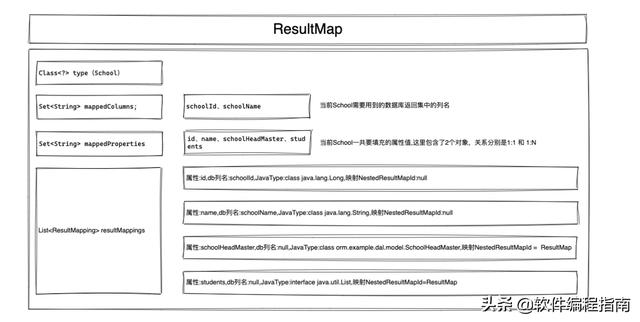
- line(25-26) 观察mybatis如何填充数据。
@Test
public void parseResultMap() {
// 读取配置信息(为什么路径前不用加/,因为是相对路径。maven编译后的资源文件和class文件都是在一个包下,所以不用加/就是当前包目录)
InputStream mapperInputStream = Thread.currentThread().getContextClassLoader().getResourceAsStream("example05/mybatisConfig-ResultMap.xml");
// 生成SqlSession工厂,SqlSession从名字上看就是,跟数据库交互的会话信息,负责将sql提交到数据库进行执行
SqlSessionFactory sqlSessionFactory = new SqlSessionFactoryBuilder().build(mapperInputStream, "development");
// 获取Mybatis配置信息
Configuration configuration = sqlSessionFactory.getConfiguration();
// 只要看这个复杂对象如何映射。
MappedStatement selectSchool = configuration.getMappedStatement("orm.example.dal.mapper.SchoolMapper.selectSchool");
ResultMap resultMap = selectSchool.getResultMaps().get(0);
// 确定是一个复杂对象,规则是XMLMapperBuilder#processNestedResultMappings,只要发现查询语句对象的结果中有以下标签"association", "collection", "case"。就是复杂sql
System.out.println("是否复杂对象:" + resultMap.hasNestedResultMaps());
List<ResultMapping> propertyResultMappings = resultMap.getPropertyResultMappings();
for (ResultMapping propertyResultMapping : propertyResultMappings) {
// 1. 属性:id,db列名:schoolId,JavaType:class java.lang.Long
// 2. 属性:name,db列名:schoolName,JavaType:class java.lang.String
// 3. 属性:schoolHeadMaster,db列名:null,JavaType:class orm.example.dal.model.SchoolHeadMaster,映射NestedResultMapId
// 4. 属性:students,db列名:null,JavaType:interface java.util.List,映射NestedResultMapId
printResultMapping(propertyResultMapping, configuration);
}
// [School(id=1, name=西天小学, schoolHeadMaster=SchoolHeadMaster(id=1, name=如来), students=[Student(id=1, name=孙悟空), Student(id=2, name=猪八戒), Student(id=3, name=唐三藏)])]
List<School> schools = configuration.getMapper(SchoolMapper.class, sqlSessionFactory.openSession(false)).selectSchool();
System.out.println(schools);
}
private static void printResultMapping(ResultMapping propertyResultMapping, Configuration configuration) {
String property = propertyResultMapping.getProperty();
System.out.println("属性:" + property + ",db列名:" + propertyResultMapping.getColumn() + ",JavaType:" + propertyResultMapping.getJavaType() + ",映射NestedResultMapId:" + propertyResultMapping.getNestedResultMapId());
String nestedResultMapId = propertyResultMapping.getNestedResultMapId();
// 如果不等于空,说明是复杂对象。从配置文件中获取复杂属性的映射集合
if (Objects.nonNull(nestedResultMapId)) {
ResultMap nestedResultMap = configuration.getResultMap(nestedResultMapId);
System.out.println(nestedResultMap.getType());
System.out.println("是否复杂对象:" + nestedResultMap.hasNestedResultMaps());
List<ResultMapping> propertyResultMappings = nestedResultMap.getPropertyResultMappings();
for (ResultMapping resultMapping : propertyResultMappings) {
printResultMapping(resultMapping, configuration);
}
}
}
下面我们就看如何填充数据了。同样我们直接手撸代码。
schoolId schoolName hmId schoolHeadName studentName studentId 1 西天小学 1 如来 孙悟空 1 1 西天小学 1 如来 猪八戒 2 1 西天小学 1 如来 唐三藏 3 2 湖畔大学 2 马云 马化腾 4 2 湖畔大学 2 马云 谢霆锋 5 2 湖畔大学 2 马云 张学友 6
Mybatis中处理返回值,分一下基础。简单对象和复杂对象这里我们直接用复杂对象距离。 可以看到School中有2个基本属性和1个对象属性还有一个集合属性。
看这个图。
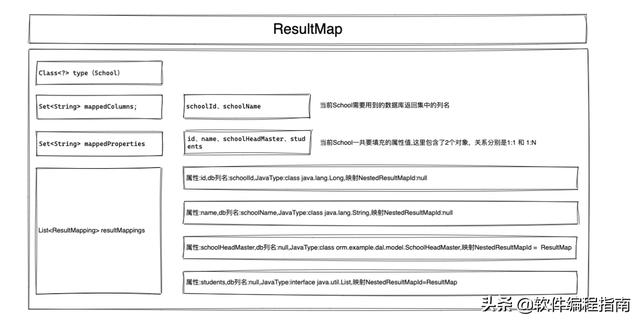
这部分示例代码在 com.test.example05.ResultMapTest#handlerResultSet
- line(26) 首先我们要获取数据库返回列信息
- line(30) 一行一行读取数据,每次执行ResultSet#next就是下一行
- line(41) 因为我们School中有一个是集合属性,需要将多行数据转换成一行。此时我们执行完getRowValue 会生成一个数据。但是这个数据不能直接就用, 还需要将第二行的数据也赋值到第一行的返回值中,这是我们就将 第一行的数据返回值,带进去。
- line(41) 我们如何知道这6行数据如何合并。规则: 简单对象进行拼接,School中简单对象是id,和name。
- line(44) getRowValue中的每个方法都要注意看
- line(93-99) 主要处理是否需要合并行,合并行的时候直接填充数据接口。而不是合并则缓存中查不到数据,就重新生成一个结果。
- line(104) 判断ResultMap是否是一个复杂对象,这里School是一个复杂对象,因为不仅有一个HeadMaster还有一个List的学生集合。
- line(109) 第一次进去这里会有4个对象,id,name,schoolHeadMaster,students
- line(115-118) 对于School中的id和name都会在这几行被执行了。可以看到根据javaType找到了TypeHandler,然后TypeHandler负责取值。
- line(141) 对于schoolHeadMaster这个属性,是复杂对象,School中的Java类型是SchoolHeadMaster和他对应的ResultMap中的类型是一样的, 则递归去获取数据,因为SchoolHeadMaster中也是都简单类型的id和name,所以最终也会在line(115-118)被执行了。
- line(125-138) School中的students,java类型是List,ResultMap中类型是Student,所以要先从第一行的数据去获取这个属性 看List是否被实例化了,如果没有就实例化。然后执行add操作给list中数据追加值。
主要这里我们使用了MetaObject这个工具,是一个包装方法。不详细介绍了,如果还不清楚请跳转
第03篇:Mybatis核心类详细介绍
@Test
public void handlerResultSet() throws Exception {
// 读取配置信息(为什么路径前不用加/,因为是相对路径。maven编译后的资源文件和class文件都是在一个包下,所以不用加/就是当前包目录)
InputStream mapperInputStream = Thread.currentThread().getContextClassLoader().getResourceAsStream("example05/mybatisConfig-ResultMap.xml");
// 生成SqlSession工厂,SqlSession从名字上看就是,跟数据库交互的会话信息,负责将sql提交到数据库进行执行
SqlSessionFactory sqlSessionFactory = new SqlSessionFactoryBuilder().build(mapperInputStream, "development");
// 获取Mybatis配置信息
Configuration configuration = sqlSessionFactory.getConfiguration();
// 只要看这个复杂对象如何映射。
MappedStatement selectSchool = configuration.getMappedStatement("orm.example.dal.mapper.SchoolMapper.selectSchool");
ResultMap resultMap = selectSchool.getResultMaps().get(0);
PreparedStatement preparedStatement = execute("select school.id as 'schoolId',n" +
" school.name as 'schoolName',n" +
" hm.id as 'hmId',n" +
" hm.name as 'schoolHeadName',n" +
" s.name as 'studentName',n" +
" s.id as 'studentId'n" +
"from schooln" +
" left join head_master hm on hm.id = school.head_master_idn" +
" left join student s on school.id = s.school_id");
// 2. 执行sql语句获取结果集
preparedStatement.execute();
ResultSetWrapper firstResultSet = getFirstResultSet(preparedStatement, configuration);
ResultSet resultSet = firstResultSet.getResultSet();
Map<String, Object> one2ManyAsMap = new HashMap<>();
// 3. 处理结果转换,一行一行读取数据
while (resultSet.next()) {
// 3.1 用于判断多行数据是否要合并 规则: 简单对象属性,如果一样则可以合并。
// 如: 下面数据返回值是 List<School> schools;School(Long id,String name,SchoolHeadMaster schoolHeadMaster,List<Student> students)
//INSERT INTO MY_TABLE(schoolId, schoolName, hmId, schoolHeadName, studentName, studentId) VALUES (1, '西天小学', 1, '如来', '孙悟空', 1);
//INSERT INTO MY_TABLE(schoolId, schoolName, hmId, schoolHeadName, studentName, studentId) VALUES (1, '西天小学', 1, '如来', '猪八戒', 2);
//INSERT INTO MY_TABLE(schoolId, schoolName, hmId, schoolHeadName, studentName, studentId) VALUES (1, '西天小学', 1, '如来', '唐三藏', 3);
//INSERT INTO MY_TABLE(schoolId, schoolName, hmId, schoolHeadName, studentName, studentId) VALUES (2, '湖畔大学', 2, '马云', '马化腾', 4);
//INSERT INTO MY_TABLE(schoolId, schoolName, hmId, schoolHeadName, studentName, studentId) VALUES (2, '湖畔大学', 2, '马云', '谢霆锋', 5);
//INSERT INTO MY_TABLE(schoolId, schoolName, hmId, schoolHeadName, studentName, studentId) VALUES (2, '湖畔大学', 2, '马云', '张学友', 6);
// 我们如何知道这6行数据如何合并。规则: 简单对象进行拼接,School中简单对象是id,和name。
// 所以这里构建的缓存key就是 id + name。相同就不新建返回值,而是对返回值二次赋值
String cacheKey = getCacheKey(resultMap, resultSet, configuration);
Object parentObject = one2ManyAsMap.get(cacheKey);
// 3.2 开始填充数据
parentObject = getRowValue(resultMap, firstResultSet, configuration, parentObject);
one2ManyAsMap.put(cacheKey, parentObject);
}
for (Object value : one2ManyAsMap.values()) {
System.out.println(value);
}
}
private PreparedStatement execute(String sql) throws Exception {
String dbUrl = "jdbc:mysql://127.0.0.1:3306/test";
String user = "root";
String pass = "123456";
// 1. 获取数据库连接
Connection connection = DriverManager.getConnection(dbUrl, user, pass);
return connection.prepareStatement(sql);
}
private ResultSetWrapper getFirstResultSet(Statement stmt, Configuration configuration) throws SQLException {
ResultSet rs = stmt.getResultSet();
while (rs == null) {
if (stmt.getMoreResults()) {
rs = stmt.getResultSet();
} else {
if (stmt.getUpdateCount() == -1) {
break;
}
}
}
return rs != null ? new ResultSetWrapper(rs, configuration) : null;
}
private static String getCacheKey(ResultMap resultMap, ResultSet resultSet, Configuration configuration) throws Exception {
StringBuffer sb = new StringBuffer();
sb.append(resultMap.getId());
List<ResultMapping> propertyResultMappings = resultMap.getPropertyResultMappings();
for (ResultMapping propertyResultMapping : propertyResultMappings) {
if (propertyResultMapping.isSimple()) {
Class<?> javaType = propertyResultMapping.getJavaType();
TypeHandler<?> typeHandler = configuration.getTypeHandlerRegistry().getTypeHandler(javaType);
sb.append(propertyResultMapping.getProperty());
Object propertyValue = typeHandler.getResult(resultSet, propertyResultMapping.getColumn());
sb.append(propertyValue);
}
}
return sb.toString();
}
private static Object getRowValue(ResultMap resultMap, ResultSetWrapper firstResultSet, Configuration configuration, Object rowValue) throws Exception {
// 获取返回值的实体类
Object returnValue = null;
// 如果不等于空说明是处理合并,那么不构建新对象,只在合并的对象上重新赋值。
if (Objects.nonNull(rowValue)) {
returnValue = rowValue;
} else {
// 等于空说明是第一次进入,直接构建返回值示例。
returnValue = configuration.getObjectFactory().create(resultMap.getType());
}
// 下面对实例方法进行赋值,利用工具类MetaObject包装提供统一的赋属性方法
MetaObject metaObject = configuration.newMetaObject(returnValue);
// 判断是否是嵌套对象
boolean nestedFlag = resultMap.hasNestedResultMaps();
ResultSet resultSet = firstResultSet.getResultSet();
// 判断是否简单对象
if (nestedFlag) {
// 非简单对象,说明需要判断属性各自需要的映射对象
List<ResultMapping> propertyResultMappings = resultMap.getPropertyResultMappings();
for (ResultMapping propertyResultMapping : propertyResultMappings) {
Class<?> javaType = propertyResultMapping.getJavaType();
String nestedResultMapId = propertyResultMapping.getNestedResultMapId();
Object propertyValue;
// 是空说明,当前属性是基本属性
if (Objects.isNull(nestedResultMapId)) {
// 获取当前属性的Java类型,从配置中获取该类型,读取ResultSet要使用的方法。eg:StringTypeHandler 使用ResultSet#getString
TypeHandler<?> typeHandler = configuration.getTypeHandlerRegistry().getTypeHandler(javaType);
propertyValue = typeHandler.getResult(resultSet, propertyResultMapping.getColumn());
} else {
// 不等于空说明是嵌套对象,从配置中读取嵌套对象的映射信息
ResultMap nestedResultMap = configuration.getResultMap(nestedResultMapId);
// 嵌套对象的java类型。eg: School(students),这里的Java类型就是Student
Class<?> nestedJavaType = nestedResultMap.getType();
// 若果是list方式,外面的javaType=list,里面是真实java对象
if (!javaType.equals(nestedJavaType) && Collection.class.isAssignableFrom(javaType)) {
propertyValue = getRowValue(nestedResultMap, firstResultSet, configuration, null);
MetaObject parentMetaObject = configuration.newMetaObject(returnValue);
// 获取父对象School 获取students的List
Object collect = parentMetaObject.getValue(propertyResultMapping.getProperty());
if (Objects.isNull(collect)) {
// 如果是null,则将list实例化
collect = configuration.getObjectFactory().create(javaType);
parentMetaObject.setValue(propertyResultMapping.getProperty(), collect);
}
// 给list中添加信息
MetaObject metaCollectObject = configuration.newMetaObject(collect);
metaCollectObject.add(propertyValue);
propertyValue = collect;
} else {
// 简单对象
propertyValue = getRowValue(nestedResultMap, firstResultSet, configuration, null);
}
}
metaObject.setValue(propertyResultMapping.getProperty(), propertyValue);
}
} else {
List<ResultMapping> propertyResultMappings = resultMap.getPropertyResultMappings();
for (ResultMapping propertyResultMapping : propertyResultMappings) {
Class<?> javaType = propertyResultMapping.getJavaType();
TypeHandler<?> typeHandler = configuration.getTypeHandlerRegistry().getTypeHandler(javaType);
Object propertyValue = typeHandler.getResult(resultSet, propertyResultMapping.getColumn());
metaObject.setValue(propertyResultMapping.getProperty(), propertyValue);
}
}
return returnValue;
}
好了到这里对于场景1中,返回list中的数据就处理好了。
private <E> Object executeForMany(SqlSession sqlSession, Object[] args) {
List<E> result;
Object param = method.convertArgsToSqlCommandParam(args);
if (method.hasRowBounds()) {
RowBounds rowBounds = method.extractRowBounds(args);
result = sqlSession.selectList(command.getName(), param, rowBounds);
} else {
result = sqlSession.selectList(command.getName(), param);
}
// issue #510 Collections & arrays support
if (!method.getReturnType().isAssignableFrom(result.getClass())) {
if (method.getReturnType().isArray()) {
return convertToArray(result);
} else {
return convertToDeclaredCollection(sqlSession.getConfiguration(), result);
}
}
return result;
}
场景二:
如果是单个对象,在基于场景一的返回值上加一个判断,如果结果只要1个就只取第一个。 如果是多个,则报错。
public <T> T selectOne(String statement, Object parameter) {
// Popular vote was to return null on 0 results and throw exception on too many.
List<T> list = this.selectList(statement, parameter);
if (list.size() == 1) {
return list.get(0);
} else if (list.size() > 1) {
throw new TooManyResultsException("Expected one result (or null) to be returned by selectOne(), but found: " + list.size());
} else {
return null;
}
}
场景三:
更新语句直接 Statement#getUpdateCount 获取更新数量
public int update(Statement statement) throws SQLException {
PreparedStatement ps = (PreparedStatement) statement;
ps.execute();
int rows = ps.getUpdateCount();
Object parameterObject = boundSql.getParameterObject();
KeyGenerator keyGenerator = mappedStatement.getKeyGenerator();
keyGenerator.processAfter(executor, mappedStatement, ps, parameterObject);
return rows;
}
场景四:
排除查询,其他语句返回都是int类型的更新成数量。那么假如方法是boolean类型,或者Long和Void呢
public class MapperMethod {
private Object rowCountResult(int rowCount) {
final Object result;
if (method.returnsVoid()) {
result = null;
} else if (Integer.class.equals(method.getReturnType()) || Integer.TYPE.equals(method.getReturnType())) {
result = rowCount;
} else if (Long.class.equals(method.getReturnType()) || Long.TYPE.equals(method.getReturnType())) {
result = (long) rowCount;
} else if (Boolean.class.equals(method.getReturnType()) || Boolean.TYPE.equals(method.getReturnType())) {
result = rowCount > 0;
} else {
throw new BindingException("Mapper method '" + command.getName() + "' has an unsupported return type: " + method.getReturnType());
}
return result;
}
}
感谢您的阅读,本文由 西魏陶渊明 版权所有。如若转载,请注明出处:西魏陶渊明()


